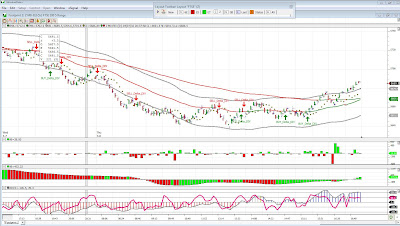Anyway, I was a member of a technical analysis group, CompuTrac, and was introduced to a trader there. He lived not far from Sunset Strip when that address was cool. In those days, Richard Sandor had just invented financial futures and the T-Bonds were the big thing to trade. Their volume was over 300,000 contracts a day which was huge in those days. To trade, you telephoned your broker and gave him your order. He repeated it back to you and then passed it on to another desk, right on the trading floor if you were a big enough client, who then hand signaled into the pit. If you were a big enough client then you could telephone the floor direct. You then had to wait for your fill. By now the market had moved so you didn't know if you were filled or not. Often you got your fill and your stop fill at the same time. There were lots of arguments and people changed brokers like they changed their socks.
So, this guy (I'll call him Bill) in LA had it all worked out. He hated to trade as it was so stressful, but he loved the money. He usually only traded once a day, near the open when the market was finding balance. In those days there was no 24 hour markets so when a market opened, it reacted to all the news since its previous close. Bill would put on his trade with a target of 8 ticks profit. He had a specific amount he wanted to earn every day and put on enough contracts to make that amount in one trade. trade over, he hopped into his Porsche and went to the beach. His work day was about 30 minutes.
How did this work? Well, not all trades are equal. Some trades are surer than others. Some times of the day are better than others due to either volatility or liquidity or both. Bill identified that and built his trading plan around it. In Chicago, in the S&P pit, there are locals who only trade the first and last hour, times when the liquidity and volatility are highest.
Where does this take us? Maybe our trading plan should be to look for the highest probability trades only, at times when the volatility and liquidity are highest. If you trade currency futures you have these times at least three times a day in different time zones, at least 2 for the ES ( opening hour and the last hour) and 3 times if you are in Europe and trade the Dow Euro 50 or DAX. This may be a good strategy in times of lower volatility. Each time I trade I take on risk. I want to maximise my reward.
Today's chart is the FTSE, the British stock index future. I could never make money trading this in the pit. I made my donations here to guys who could really move this market around. Electronically, their edge is gone and its a good market on lots of days.
Click to enlarge


Great story, Tom,
ReplyDeletewhich times of the day are the best for the FESX? 9am 2.30pm and 4pm (all GMT+1)?
Cheers,
Markus
EL, thank you again for all the work that you do and share with us. Question: what time is the open and time of highest liquidity for the Euro?
ReplyDeleteHi Tom
ReplyDeleteI would like ask you can you write a few words about background and context your trades as you wrote for examp.in post from 16 February 2010. I think is better for readers ,just as some arrows in chart.
great blog/points and very relevant to your reasoning for why you say "I’ve always discouraged my kids from becoming traders. It's a hard way to make a consistent living unless you have strong discipline and focus. " and the rationale for the flobot. It also reminds of of one of the comments in Market Wizards from some one who basically said ... i just wait for the market to provide an opportunity and then I go over and pick it up, otherwise I wait.
ReplyDeleteHello Tom,
ReplyDeleteI got a lot chopped up in the last days,
could you please, if your time allows, give some clues on how to deal with markets, when EMAs are horizontal.
Like, when to change your thinking (inside out > outside in)
What do you generally look for?
What should be there for a break out?
An example whould be brilliant.
I think this whould really be very helpfull.
Again, thanks a lot for the really great blog!